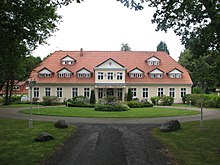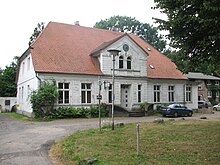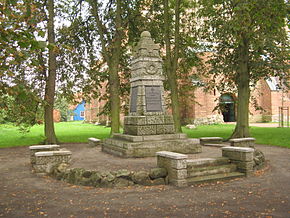Wiek (Ruegen)
| coat of arms | Germany map | |
|---|---|---|

|
Coordinates: 54 ° 37 ' N , 13 ° 17' E |
|
| Basic data | ||
| State : | Mecklenburg-Western Pomerania | |
| County : | Western Pomerania-Ruegen | |
| Office : | North Ruegen | |
| Height : | 2 m above sea level NHN | |
| Area : | 25.44 km 2 | |
| Residents: | 1036 (Dec. 31, 2019) | |
| Population density : | 41 inhabitants per km 2 | |
| Postal code : | 18556 | |
| Area code : | 038391 | |
| License plate : | VR, GMN, NVP, RDG, RÜG | |
| Community key : | 13 0 73 101 | |
| Office administration address: | Ernst-Thälmann-Strasse 37 18551 Sagard |
|
| Website : | ||
| Mayoress : | Petra Harder | |
| Location of the community Wiek in the district of Vorpommern-Rügen | ||
Wiek , formerly also Wieck , is a municipality in the district of Vorpommern-Rügen on the island of Rügen in Mecklenburg-Western Pomerania (Germany). The municipality is administered by the North Rügen Office with its seat in the municipality of Sagard .
Geography and traffic
Wiek is located about 30 kilometers northwest of Bergen on Rügen on the Wittow peninsula . The community is on Highway 30, either on the Spit of Schaabe to reach or the Wittower Ferry , a car ferry between the municipalities and Wiek Trent . Wiek borders the Wieker Bodden in the west, which is separated from the Baltic Sea in the west by the Bug peninsula, making it a good natural harbor. In the south the bay has a narrow connection to the sea. From Wiek there is a regular ferry service to the island of Hiddensee .
From December 21, 1896 to September 10, 1968, the 750 mm narrow-gauge railway line Bergen – Trent – Wittower ferry – Wiek – Altenkirchen of the Rügen Kleinbahn (RüKB) ran through Wiek.
Districts
|
|
history
Bohlendorf
Since the 13th century, Bohlendorf was the ancestral seat of the von Bohlen family with an estate of 264 hectares. This family also gave the place its name and remained until the Second World War. In 1794 Ernst Casimir von Bohlen had today's manor house built. After the owners died childless, Alexander von Quistorp bought Gut Bohlendorf in 1942. The estate was sprawled out in 1945 with the land reform. The manor house was used as a residential building for resettlers, later used as a holiday complex for VEB Erdöl-Erdgas Grimmen . After the reunification, the manor house was extensively renovated and a hotel was set up.
Parchow
Estate of the von Viersen (until 1561), von Platen (until 1909) and Th. Witthohn (until 1945) families . The unrenovated manor house from around 1840 and the outbuildings are falling into disrepair - not an unusual circumstance with regard to the numerous Mecklenburg and Western Pomerania manors.

As K
The place was first documented as Vikr in 1165 . There was also talk of a Slavic castle wall. After 1168 the area of Wiek was also Christianized. In the course of time, more and more Germans settled in the place and the Slavic population was assimilated. In 1314 and 1318 a parochia Medowe sive Wyk , i.e. a Med floodplain or honey meadow near Wyk, was described (East German Medouve - Med = honey, ouve = floodplain).
In the Slavic settlement areas, the building or farm yards belonging to the rulers' castle were named Bauwiek or simply Wiek. The Slavs (for Rügen - the Ranen) were settled there (see corresponding districts e.g. in Stettin, Greifswald and Gützkow).
The Germanic WIC is related to the Latin vicus = place and victual = food. It is also known in Anglo-Saxon as wicing , (see Widsith- Poem). The Frisian Wik or Wyk for bay also indicates a market place or trading place, because these developed on bodies of water and especially in bays.
Like all names, it changed over the centuries. In 1314 and 1318 it was called Medove sive Wiek and Medove sive Wyk , in 1324 only Wik , later de Wyke, Wick, Wieck and today again Wiek .
- middle Ages
The name Medove , meaning honey meadow, could lead to the assumption that meadow beekeeping was the basis of the inhabitants' working life here. The place should also have been surrounded by the castle walls typical of Rügen (such as Arkona or Charenza ) and by forests. The Wittow peninsula was settled around 1000 by the Polish- speaking Slavic people of the Ranen (Rujanen), named after the Rugians who lived here before the migration .
The Danes fought several times for the peninsula in the 12th century and finally won in 1168. German settlers came and lived next to the Slavic inhabitants. Over the centuries, the language, customs, religion and agriculture changed. In 1404 the last inhabitant of Jasmund who still spoke Wendish died.
1314 Wiek was in a tax list of the Rügen prince Wizlaw III. listed, and then seems to have a very considerable population. Wiek was mentioned again in a document in 1318. After the death of Witzlaw III. complaints came to the Duchy of Pomerania-Wolgast and 1350, there was the bailiff as a representative of the prince. In 1355 knight Johann von Kyle (Kiel) sold his goods from Wiek and Goos. The construction of the village church began around 1400 . In 1421 the socially oriented wretched brotherhood and in 1456 the Corpus Christi brotherhood were already mentioned in Wiek. Around 1453 the pirate system of the Vitalienbrüder under Klaus Störtebecker and Gödeke Michels was very active in this area. In 1462 the poor house of St. Jürgen was set up in Wiek. In 1515, Duke Bogislaw X. Heinrich von der Lancken enfeoffed "with de Wyke gantz" among other things . The place belonged to the Lanckens and the nunnery in Bergen at that time.
- 17th to 18th centuries
In the Thirty Years War , Rügen and thus Wiek suffered just as much as the whole of Pomerania. From 1627 to 1630 Wallenstein's imperial troops were on Rügen. Famine and disease reduced the population considerably. After the Swedish occupation Wiek - in contrast to Pomerania - was able to recover from the war. It came to Sweden in 1648 with Western Pomerania . The war between Sweden and Brandenburg (1678) and the Great Northern War also affected Wiek. In 1711 Field Marshal Graf Stenbock landed on Wittow with about 10,000 men; the place had to provide clamping services. In 1730, however, it was said: “Wiek is well-inhabited and populous. The inhabitants are under some aristocratic rule, there are also church builders here. ” It was not until 1806 that the Swedish king revoked serfdom . The occupation by French troops from 1807 to 1810 was also noticeable in the place. In 1815 Wiek became Prussian.
- Recent history
Since 1818 Wiek belonged to the district of Rügen . Only from 1952 to 1955 it was part of the Bergen district. The community then belonged to the Rügen district in the Rostock district until 1990 and became part of the state of Mecklenburg-Western Pomerania in the same year. The district of Rügen, which has been called this again since 1990, was merged in 2011 in the district of Vorpommern-Rügen .
In 1819 Wiek was the largest village on Rügen. The syringe house was built in 1820. Fritz Reuter wrote about Wiek in 1830: “In the morning I wandered to Wittow, the Rügen granary. There was the loveliest, richly decorated little country in the summer morning, girded by the sun-bound sea, in infinite variety through the bays, Bodden and Wyken, ... “In 1850 Wiek can list two school locations (in the sexton's house and in a separate house).
In 1872 parts of Wiek were under water during the great storm flood in November. Three years later the cemetery was laid out on the old Slavic Wall. The ramparts originate from the 11th and 12th centuries and are locally called "Borgwall".
In 1883 the place received an imperial post office in the Gasthof Schröder (Hotel Bismarck).
In 1890 the construction of the port and a small railway began, which were intended on the one hand for the local fishermen and on the other hand for the chalk removal from the chalk quarries near Cape Arkona . The Schützenplatz was laid out in 1898. In 1903 the place received its first street lighting. A gravel road connected Wiek with Altenkirchen since 1907 . In 1915, due to the war, work on the expansion of the chalk harbor, which began in 1912, was stopped. The loading bridge built in 1914, the so-called chalk bridge , was preserved as evidence of the planned chalk mining . This bridge was one of the earliest reinforced concrete structures in the Baltic Sea region. Also in Wiek there was some unrest among the stationed sailors at the end of the First World War .
From 1920 the Saxon Children's Home was built as a children's convalescent home. By 1928 this was expanded to accommodate around 1200 children's places. Today's school building was built in 1928. At the same time, the Alwert shipping company was founded. Around 1929/1930 the National Socialists were also able to gain a foothold in Wiek. Storm troops did some harm. In 1936 another real storm swept the place that was remarkable. The port was expanded around 1934/1935. In 1938 a new vocational school was built. From 1935 soldiers were stationed on the nearby Bug , and since then this part of the peninsula has been heavily influenced by military forces with interruptions until 1992. On May 5, 1945, the place was occupied by the Red Army without a fight .
In 1949/1950 the school was expanded due to the strong increase in population.
After the reunification, the place was extensively redeveloped from 1992 with the help of urban development funding. The Wieker port was extensively expanded and modernized between 2001 and 2004. The Marina Wiek has berths for 150 yachts. The chalk bridge , which has been an investment ruin in the port since it was built in 1914, was renovated in 2014 and transformed into a promenade. The costs for this amounted to around € 2.3 million.
Woldenitz
Since the 13th century, Woldenitz was the ancestral seat of the von der Lancken family , a Rügen family of the ancient nobility. When the last lord von der Lancken-Woldenitz died childless, the feudal and knightly estate was sold to the neighbor Wilhelm von Platen auf Parchow in 1893 . The current manor house was built at the end of the 18th century; it is by a pond in a small park. In 1945 the manor house and land were relocated and distributed to local residents, mostly refugees.
Zürkvitz
In Zürkvitz there was a manor that last belonged to the von Bothmer family until 1945 .
Population development
| year | Residents |
|---|---|
| 1168 | at 250 |
| 1577 | at 350 |
| 1805 | 580 |
| 1817 | 729 |
| 1850 | 1239 |
| 1905 | 1140 |
| 1933 | 1442 |
| 1950 | 2243 |
| 2000 | 1269 |
politics
coat of arms
The coat of arms was approved by the Ministry of the Interior on June 12, 2001 and registered under the number 246 of the coat of arms of Mecklenburg-Western Pomerania.
Blazon : “Divided; above in red two diagonally crossed golden flails, the intersection covered by a golden beehive; below in gold a blue Viking boat with a sail. "
The coat of arms was designed by Gerhard Koggelmann from Sagard.
Twin cities
- Łobez , Poland with Szczecin since 2008
- Bremen-Blumenthal , Germany, in Bremen
Sights and culture
→ See: List of architectural monuments in Wiek (Rügen)
- The parish church of St. Georg zu Wiek , a Gothic brick church built around 1400 with a belfry (around 1600)
- War memorial from 1923 in memory of those who fell in the First World War on the church grounds
- The harbor (redesigned until 2003) with the old chalk bridge
- The children's health home, built until 1929 according to plans by Bauhaus student Waldo Wenzel
- The Wieker Blasmusik eV is an orchestra that is well known beyond local borders. It was founded in 1958.
Personalities
- Karl Christian Heller (1770–1837), Protestant theologian, librarian and chronicler
- Theodor Schwarz (1777–1850), Protestant theologian, pastor, writer and painter
- Karl Schwarz (1812–1885), Protestant theologian and university professor
- Julius von Platen (1853–1922), Prussian lieutenant general
- Rüdiger Hoth (* 1940), civil engineer and master builder of the cathedral
- Thorolf Oeing (* 1943), politician (CDU / REP), member of the Bremen citizenship
literature
- Günter Käning: Wiek / Rügen; Chronicle of an island village . Ehrenklau publishing house, Lauterbach 1992, ISBN 3-9801496-1-7 .
Web links
Individual evidence
- ↑ Statistisches Amt MV - population status of the districts, offices and municipalities 2019 (XLS file) (official population figures in the update of the 2011 census) ( help ).
- ^ Hubertus Neuschäffer: Western Pomerania's castles and mansions. Husum Druck- und Verlagsgesellschaft 1993, p. 38, ISBN 3-88042-636-8
- ↑ Marina Wiek homepage, accessed April 23, 2017
- ^ " Historic chalk bridge opened in Wiek on Rügen ", Die Welt from July 18, 2014











